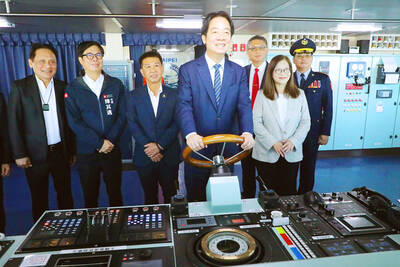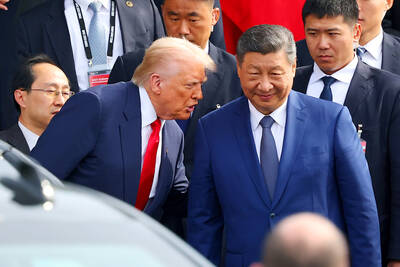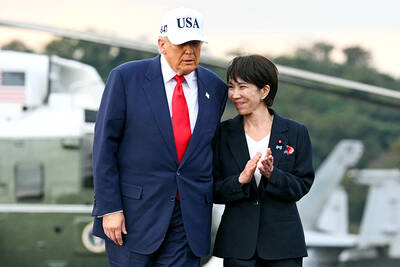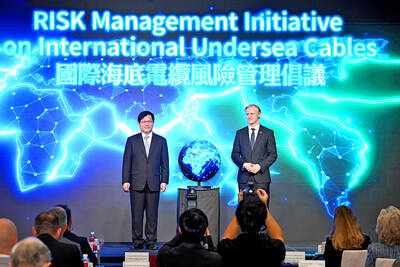An investigation has found no mechanical problems underlying the Tuesday disappearance of an F-16 jet and its pilot, the Ministry of National Defense (MND) said yesterday, adding that it does not rule out an accident due to “spatial disorientation.”
An air force F-16 jet on Tuesday evening disappeared from radar screens, just two minutes after it took off from Hualien Air Base, while the 44-year-old pilot, Colonel Chiang Cheng-chih (蔣正志), has yet to be found.
Minister of National Defense Yen De-fa (嚴德發) yesterday morning headed to Hualien for updates on the search and rescue, while giving a pep talk to Chiang’s unit, the 5th Tactical Fighter Wing.

Photo: Courtesy of Air Force Command Headquarters, MND
The ministry yesterday evening released the preliminary findings of its investigation at a news conference in Taipei.
Radio communications and maintenance records indicate that all systems were normal, and the chance of an accident due to mechanical failure is low, air force Commander General Hsiung Hou-chi (熊厚基) said.
That night it was drizzling, with visibility of about 4 nautical miles (7.5 km), he added.

Photo: CNA
While the jet took off and smoothly rose to an altitude of 2,100m, its altitude had dropped to 1,200m after 14 seconds and to sea level after 20 seconds, he said, citing readings from air force flight radar.
The military does not rule out that the pilot might have experienced spatial disorientation or an optical illusion during the ascent, he said.
Sixteen aircraft and 24 vessels have been mobilized for the search and rescue operation, he said, adding that yesterday morning, a navy vessel intercepted a signal that might have been from the missing jet.
“The military will not give up the hope of bringing Chiang home,” Hsiung said.
All F-16 jets have been grounded and while they are being inspected, Indigenous Defense Fighter jets are covering their duties, Deputy Minister of National Defense Chang Che-ping (張哲平) said earlier yesterday.
Some have said that the incident points to the increased pressure shouldered by the military as there are more frequent incursions by Chinese People’s Liberation Army (PLA) aircraft, but Chang disagreed.
PLA aircraft are typically detected in the nation’s southwest air defense identification zone (ADIZ), so jets are mobilized from bases in Chiayi County or farther south, not from Hualien, Chang said.
Three PLA aircraft — a Y-8 anti-submarine warfare aircraft, a Y-8 electronic warfare aircraft and a Y-9 electronic warfare aircraft — were intercepted in the nation’s southwest ADIZ, military data showed yesterday.
President Tsai Ing-wen (蔡英文) yesterday morning said that the air force has been instructed to conduct a thorough investigation of Tuesday’s incident, with those liable shouldering their share of the responsibility.
The ministry must remain vigilant regarding the nation’s defense, Tsai said, while calling on the public to show their support for the military.
Fifteen military personnel have been lost so far this year in drills or training incidents, including late Chief of the General Staff General Shen Yi-ming (沈一鳴), who was killed in a Black Hawk helicopter crash in New Taipei City on Jan. 2.
Additional reporting by CNA

CALL FOR SUPPORT: President William Lai called on lawmakers across party lines to ensure the livelihood of Taiwanese and that national security is protected President William Lai (賴清德) yesterday called for bipartisan support for Taiwan’s investment in self-defense capabilities at the christening and launch of two coast guard vessels at CSBC Corp, Taiwan’s (台灣國際造船) shipyard in Kaohsiung. The Taipei (台北) is the fourth and final ship of the Chiayi-class offshore patrol vessels, and the Siraya (西拉雅) is the Coast Guard Administration’s (CGA) first-ever ocean patrol vessel, the government said. The Taipei is the fourth and final ship of the Chiayi-class offshore patrol vessels with a displacement of about 4,000 tonnes, Lai said. This ship class was ordered as a result of former president Tsai Ing-wen’s (蔡英文) 2018

UKRAINE, NVIDIA: The US leader said the subject of Russia’s war had come up ‘very strongly,’ while Jenson Huang was hoping that the conversation was good Chinese President Xi Jinping (習近平) and US President Donald Trump had differing takes following their meeting in Busan, South Korea, yesterday. Xi said that the two sides should complete follow-up work as soon as possible to deliver tangible results that would provide “peace of mind” to China, the US and the rest of the world, while Trump hailed the “great success” of the talks. The two discussed trade, including a deal to reduce tariffs slapped on China for its role in the fentanyl trade, as well as cooperation in ending the war in Ukraine, among other issues, but they did not mention

Japanese Prime Minister Sanae Takaichi yesterday lavished US President Donald Trump with praise and vows of a “golden age” of ties on his visit to Tokyo, before inking a deal with Washington aimed at securing critical minerals. Takaichi — Japan’s first female prime minister — pulled out all the stops for Trump in her opening test on the international stage and even announced that she would nominate him for a Nobel Peace Prize, the White House said. Trump has become increasingly focused on the Nobel since his return to power in January and claims to have ended several conflicts around the world,

GLOBAL PROJECT: Underseas cables ‘are the nervous system of democratic connectivity,’ which is under stress, Member of the European Parliament Rihards Kols said The government yesterday launched an initiative to promote global cooperation on improved security of undersea cables, following reported disruptions of such cables near Taiwan and around the world. The Management Initiative on International Undersea Cables aims to “bring together stakeholders, align standards, promote best practices and turn shared concerns into beneficial cooperation,” Minister of Foreign Affairs Lin Chia-lung (林佳龍) said at a seminar in Taipei. The project would be known as “RISK,” an acronym for risk mitigation, information sharing, systemic reform and knowledge building, he said at the seminar, titled “Taiwan-Europe Subsea Cable Security Cooperation Forum.” Taiwan sits at a vital junction on